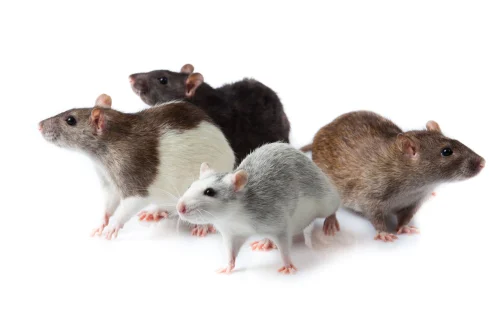Classification
Species category: Rodent
Scientific name: Mus musculus
Family: Muridae
Description :
Adults are typically 60-90mm. They have a tail-length of 80-100mm long and weigh 20g-30g maximum. Droppings can be useful for identification purposes; theirs are formed like grains of rice and are approx. 3-6mm long.
The House mouse originated from East-Asia and has spread throughout the world in distributed grain and food.
Mice tend to live in grassy or bushy areas, making their nests in shallow burrows but can also be found above ground nesting in densely vegetated spaces. Outdoors they can be found in leaf piles or wood piles, even a stack of bricks can provide the right shelter.
When the weather turns colder they come indoors in search of warmth. They will live close to a source of food and destroy materials in the vicinity to build a nest.
Behavior :
Outdoors they will breed throughout the summer only and indoors they will breed continuously. Mice never move too far from their nest, and always use the same route when travelling to and from it, preferring to navigate around the edge of a room. Grease build-up in their fur, from urine and dust, creates smear marks which can be evident.
Risks :
Mice are practically incontinent and urinate frequently. As a result, a mice infestation is normally recognized by distinct musty smell of their urine. They contaminate all surfaces that they scurry across with urine and faeces. They can produce up to 80 droppings a day.
Commercially, they cause direct food losses to field crops and stored food and food production chains, as well as indirect food losses, such as packaging destruction.
Classification
Species category : Rodent
Scientific name : Bandicota benghalensis; Bandicota indica
Family : Muridae
Description :
Adults are typically 190-330mm long (excluding the tail). The tail is slightly shorter than their bodies. Droppings can be useful for identification purposes; theirs are formed like an olive pit, ending in a point and are approximately 25mm long. They are big size rodents, larger, stronger with blackish brown body and rounded head.
Bandicoots originated from Asia and are widespread in various continents.
They are often found outdoors and tend to live in fields and farmlands. They do not usually enter buildings but stay in the vicinity of the garbage dumping areas in cities.
Behavior :
Bandicoot rats are aggressive burrowers making tunnels even in concrete foundations and warehouses. These rodents are hoarders and may cache huge amount of grain in their burrows. Quite aggressive when threatened and make pig-like grunts while attacking.
Risks :
They are considered serious pests of field crops, grains, fruit crops, gardens, etc
Classification
Species category: Rodent
Scientific Name: Rattus rattus
Family: Muridae
Description
Adults are typically 180-230mm with a longer tail length of 180-240mm. They weigh 170-340g. Droppings are useful for identification; theirs are 12mm long and formed to a point.
As per the name Roof Rats are expert climbers and are usually black to light brown in colour with a lighter underside. The tail is longer than their body, they have poor eye sight, but they make-up for this with their keen sense of hearing, smell, taste and touch.
Roof Rats originated from India and Eastern Africa and can now be found worldwide.
They are often found outdoors and tend to live in fields and farmlands. They will also climb into buildings and structures when food sources are no longer readily available.
Behavior :
Roof Rats have incisors that grow at a rate of 4 inches per year. Rats control their incisor teeth by continuously chewing, which can result in extensive damage. They will chew on anything that comes in their path causing considerable destruction.
They also urinate and produce droppings frequently; contaminating everything they come into contact with. Roof rats are quickly able to detect and avoid new objects placed in the familiar environment.
Risks :
Carriers of over 45 types of diseases, Roof Rats contaminate water, food and the environment. In nursing homes they are also known to eat away body parts of small children in India. Rats cause direct food losses to field crops and stored food and food production chains, as well as indirect food losses, such as packaging destruction and contamination with faces.



